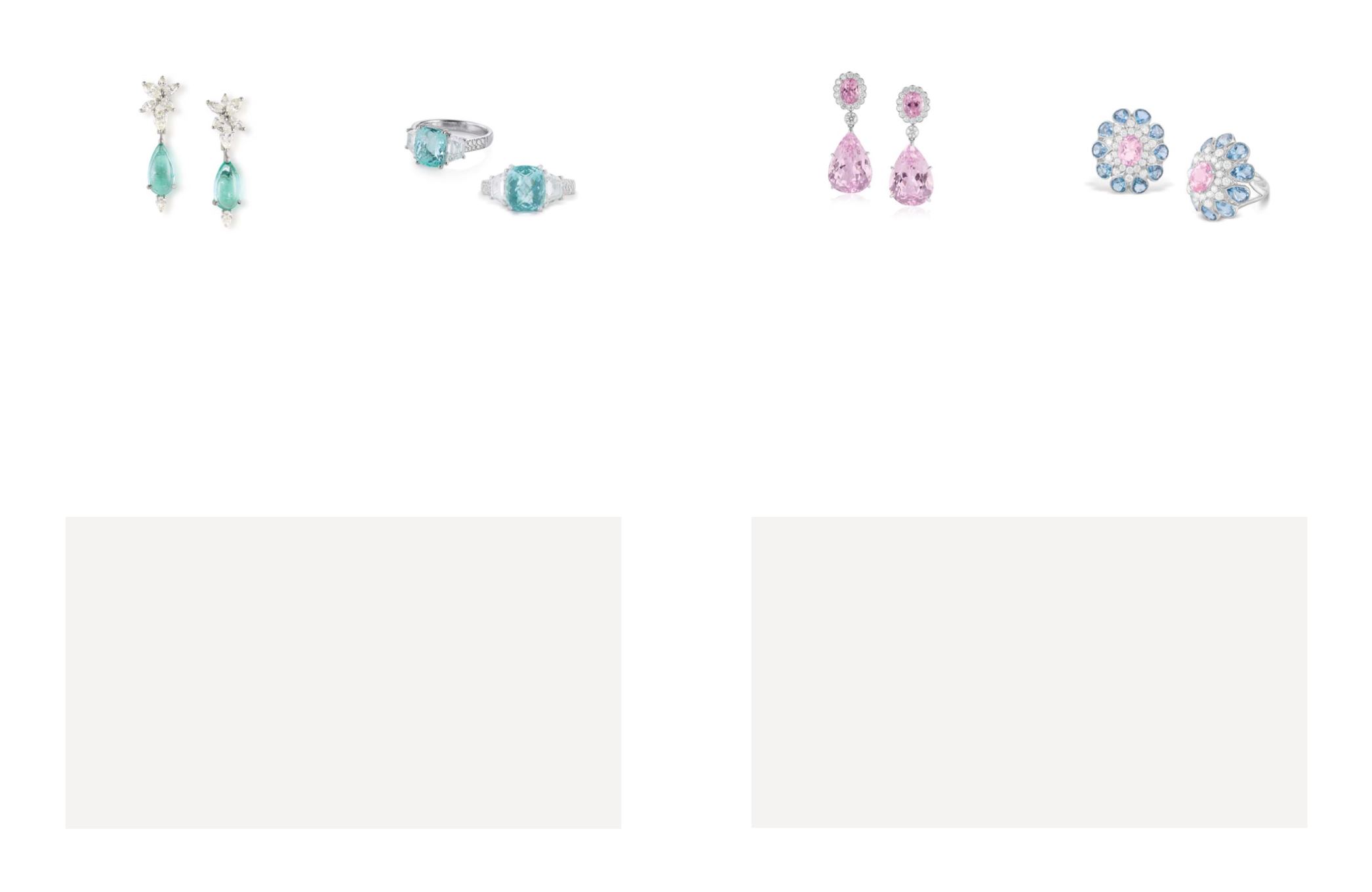

76
77
90
TOURMALINE AND DIAMOND RING
Centring on a cushion‒shaped paraíba tourmaline, to
each shoulder set with a trapezoid‒shaped diamond.
The shank is partially pavé‒set with diamonds,
mounted in gold. Stamped ‘750’.
Paraíba tourmaline: 2.97 carats
Diamond: 1.28 carats
Gross weight: 4.52 grams
$ 12,860 ‒ 17,145
Rs 9,00,000 ‒ 12,00,000
Ring size: American 6 3/4, English N
89
PAIR OF PARAÍBA TOURMALINE AND
DIAMOND EARRINGS
Each suspending a pear‒shaped cabochon paraíba
tourmaline suspending from an open work of marquise
and pear‒shaped diamonds, mounted in gold. Stamped
‘750’.
Paraíba tourmaline: 3.63 carats
Diamond: 1.50 carats
Gross weight: 5.08 grams
$ 4,290 ‒ 5,715
Rs 3,00,000 ‒ 4,00,000
91
PAIR OF KUNZITE AND DIAMOND
EARRINGS
Classic in design, consists of a well‒matched pair
of pear‒shaped kunzites in a prong‒setting, each
suspended from a surmount of an oval‒shaped kunzite
with a diamond‒set surround in a stylised mount of
white gold.
Kunzite (bottom): 51.04 carats
Kunzite (top): 5.49 carats
Diamond: 1.56 carats
Gross weight: 21.73 grams
$ 8,575 ‒ 11,430
Rs 6,00,000 ‒ 8,00,000
92
KUNZITE, AQUAMARINE AND
DIAMOND RING
A pastel‒coloured cocktail ring centring on an oval‒
shaped kunzite with an immediate surround of full‒
cut dimonds and an outer surround of pear‒shaped
aquamarines, with a shank of white gold.
Kunzite: 2.46 carats
Aquamarine: 5.79 carats
Diamond: 1.62 carats
Gross weight: 9.11 grams
$ 2,145 ‒ 3,575
Rs 1,50,000 ‒ 2,50,000
tunnels.” (“Paraiba Tourmaline,”
International Coloured Gemstone Association,
gemstone.org,
online) The first handful of these spirited blue tourmalines, in a colour the world had never
witnessed before, was brought up from the mines into the daylight in the autumn of 1989.
The difficulty in mining Paraíba tourmalines is what makes these gems among the most expensive
in the world. They are mined mostly by hand, with manual tools like wedges and sledgehammers,
as other tools and machines could cause damage to the crystals. In Brazil, the stones in the rough
are often found in small, thin veins. Over the years, these mines have been largely exhausted,
making Paraíba tourmalines even more rare and valuable.
However, as recently as 2003, similar cupriferous tourmalines were unearthed in the copper‒
rich mountains of Mozambique and Nigeria. Uncannily similar to those mined in Brazil, with
only minute chemical differences, the discovery of these natural wonders was welcome news
for connoisseurs. The name Paraíba, which stood for the region the tourmaline came from, has
now become synonymous with these luminous blue gemstones, which are the birthstones for the
month of October.
I
n 1902, an unknown pink crystal was found in San Diego, California, and sent to the
legendary Tiffany & Co. mineralogist George F Kunz – after whom the gemstone is named.
He recognised it as a unique variant of the mineral spodumene, occurring in shades of pink and
violet. The soft colour, seen in lots 91, 92 and 168, comes from trace amounts of manganese.
Currently, kunzite supplies come mainly from Afghanistan and Pakistan, and several deposits
are also found in California.
Kunzite crystals are often large, with relatively few inclusions, and make for fine finished gems
usually ranging from 10‒40 carats. The largest kunzite in the world, a faceted heart‒shaped
crystal weighing 880 carats, is on display at the Smithsonian Institution. One of the most famous
pieces of jewellery made with this gemstone was a ring set with a 47‒carat cushion‒cut kunzite,
belonging to the Estate of Jacqueline Kennedy.


















